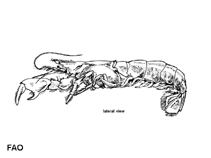Upogebia pusilla (Petagna, 1792)
Mediterranenan mud shrimp
Classification / Names Common names | Synonyms | CoL | ITIS | WoRMS
Malacostraca | Decapoda | Upogebiidae
Environment: milieu / climate zone / depth range / distribution range Ecology
Benthopelagic; brackish; pH range: 9.0 - 36.0; depth range 1 - 45 m (Ref. 128511). Subtropical; 48°N - 20°N, 19°W - 42°E
Distribution Countries | FAO areas | Ecosystems | Occurrences | Introductions
Eastern Atlantic, Mediterranean, Black Sea and Red Sea.
Length at first maturity / Size / Weight / Age
Maturity: Lm ? range ? - ? cm Max length : 8.0 cm BL male/unsexed; (Ref. 128511); common length : 6.5 cm TL male/unsexed; (Ref. 4)
Short description Morphology
Rostrum ending in 3 teeth, the median long with a rounded apex ending in two spines; lateral teeth short, much shorter than half the median tooth, and separated from it by a deep groove. The median groove of the median tooth shallow. No spines on ventral surface of the rostrum. Anterolateral margin of the carapace with a small but distinct tooth at the level of the eye. First pereiopods subchelate. In the adult male the palm is distinctly widened at the base of the fixed finger, so that the height of the chela is only slightly less than the length. Movable finger with blunt tubercles on the cutting edge, but otherwise without tubercles, spines or ridges. Palm with 2 dorsal rows of spinules. Merus with a subdistal anterodorsal spine (Ref. 4).
It has a total body length of 4 to 6.5 cm (Ref. 4). It is found in intertidal and subtidal zones down to about 45 m, sometimes in estuarine areas. It makes simple Y-shaped burrows with 2 or more entrances in the mud or sandy mud (Ref. 4).
Life cycle and mating behavior Maturity | Reproduction | Spawning | Eggs | Fecundity | Larvae
Members of the order Decapoda are mostly gonochoric. Mating behavior: Precopulatory courtship ritual is common (through olfactory and tactile cues); usually indirect sperm transfer.
Main reference
References | Coordinator | Collaborators
Holthuis, L.B. 1991. (Ref. 4)
IUCN Red List Status (Ref. 130435)
CITES status (Ref. 108899)
Not Evaluated
CMS (Ref. 116361)
Not Evaluated
Threat to humans
Human uses
Fisheries: subsistence fisheries; bait: usually
| FishSource |
Tools
More information
Internet sources
BHL | BOLD Systems | CISTI | DiscoverLife | FAO(Publication : search) | Fishipedia | GenBank (genome, nucleotide) | GloBI | Gomexsi | Google Books | Google Scholar | Google | PubMed | Tree of Life | Wikipedia (Go, Search) | Zoological Record
Estimates based on models
Price category
(Ref. 80766):
Unknown.



